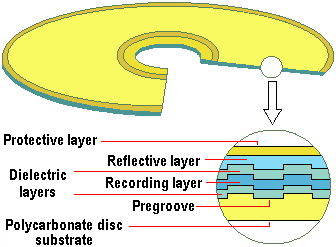Just as CD-R appeared to be on the verge of becoming a consumer product, the launch of CD-Rewritable CD-ROM, or CD-RW, in mid-1997 posed a serious threat to its future and provided further competition to the various superfloppy alternatives.
The result of a collaboration between Hewlett-Packard, Mitsubishi Chemical Corporation, Philips, Ricoh and Sony, CD-RW allows a user to record over old redundant data or to delete individual files. Known as Orange Book III, CD-RW’s specifications ensure compatibility within the family of CD products, as well as forward compatibility with DVD-ROM.
The technology behind CD-RW is optical phase-change, which in its own right is nothing radical. However, the technology used in CD-Rewritable does not incorporate any magnetic field like the phase-change technology used with MO technology. The media themselves are generally distinguishable from CD-R discs by their metallic grey colour and have the same basic structure as a CD-R disc but with significant detail differences. A CD-RW disc’s phase-change medium consists of a polycarbonate substrate, moulded with a spiral groove for servo guidance, absolute time information and other data, on to which a stack (usually five layers) is deposited. The recording layer is sandwiched between dielectric layers that draw excess heat from the phase-change layer during the writing process. In place of the CD-R disc’s dye-based recording layer, CD-RW commonly uses a crystalline compound made up of a mix of silver, indium, antimony and tellurium. This rather exotic mix has a very special property: when it’s heated to one temperature and cooled it becomes crystalline, but if it’s heated to a higher temperature, when it cools down again it becomes amorphous. The crystalline areas allow the metalised layer to reflect the laser better while the non-crystalline portion absorbs the laser beam, so it is not reflected.

In order to achieve these effects in the recording layer, the CD-Rewritable recorder use three different laser powers:
- the highest laser power, which is called Write Power, creates a non-crystalline (absorptive) state on the recording layer
- the middle power, also known as Erase Power, melts the recording layer and converts it to a reflective crystalline state
- the lowest power, which is Read Power, does not alter the state of the recording layer, so it can be used for reading the data.
During writing, a focused Write Power laser beam selectively heats areas of the phase-change material above the melting temperature (500-700 oC), so all the atoms in this area can move rapidly in the liquid state. Then, if cooled sufficiently quickly, the random liquid state is frozen-in and the so-called amorphous state is obtained. The amorphous version of the material shrinks, leaving a pit where the laser dot was written, resulting in a recognisable CD surface. When an Erase Power laser beam heats the phase-change layer to below the melting temperature but above the crystallisation temperature (200 oC) for a sufficient time (at least longer than the minimum crystallisation time), the atoms revert back to an ordered state (i.e. the crystalline state). Writing takes place in a single pass of the focused laser beam; this is sometimes referred to as direct overwriting and the process can be repeated several thousand times per disc.
Once the data has been burned the amorphous areas reflect less light, enabling a Read Power laser beam to detect the difference between the lands and the pits on the disk. One compromise here is that the disc reflects less light than CD-ROMs or CD-Rs and consequently CD-RW discs can only be read on CD players that support the new MultiRead specification. Even DVD-ROM drives, which themselves use the UDF file format, need a dual-wavelength head to read CD-RW.
CD-RW drives are dual-function, offering both CD-R and CD-RW recording, so the user can choose which recordable media is going to be the best for a particular job. By mid-1998 devices were capable of reading at 6-speed, writing both CD-R and CD-RW media at 4-speed. By the end of that year read performance had been increased to 16-speed – a level of performance at which the need for a dedicated, fast CD-ROM drive for everyday access to disc-based data was debatable. By late 2000 the best drives were capable of writing CD-RW/CD-R media and of reading CD-ROMs at 10/12/32-speed. Six months later the top performing drives were rated at 10/24/40.
Although UDF allows users to drag and drop files to discs, CD-RW isn’t quite as easy to use as a hard disk. Initially limitations in the UDF standard and associated driver software meant that when data was deleted from a CD-RW, those areas of the disc were merely marked for deletion and were not immediately accessible. A disc could be used until all its capacity was used, but then the entire disc had to be erased to reclaim its storage space using a sequential erase function. In hardware terms erasing a disk is accomplished by heating up the surface to a lower temperature, but for a longer time, which returns it to the crystalline state.
Evolution of the UDF standard and developments in associated driver software have improved things considerably, making CD-RW behave more like, but still not quite in identical fashion to, hard drives or floppy disks.
- ISO 9660 Data Format for CDs, CD-ROMs, CD-Rs and CD-RWs
- CD-R – Recordable Compact Disk
- CD Rewritable
- CDR-RW Mini Media
- CDR-RW Digital Audio Media
- CDR-RW Double Density Media
- CDR-RW UDF File System
- CDR-RW Multi-Read Technology
- CD-ROM Burn Proof Technology
- CDR-RW Disc Capabilities
- CDR-RW Over-burning
- CDR-RW Mount Ranier
- CDR-RW DiscT@2 Technology
wha
trolololololol
f yall